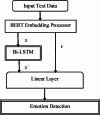Intelligent emotion sensing using BERT BiLSTM and generative AI for proactive customer care
- PMID: 41034436
- PMCID: PMC12489089
- DOI: 10.1038/s41598-025-15501-y
Intelligent emotion sensing using BERT BiLSTM and generative AI for proactive customer care
Abstract
Contact centers now rely on intelligent chatbots and virtual assistants that detect and respond to customer emotions in real time. The paper presents a novel method for detecting emotions in customer care chat by utilizing a hybrid model that combines the BERT (Bidirectional Encoder Representations from Transformers) and Bi-LSTM (Bidirectional Long Short-Term Memory) networks. This combination of features enhanced AI capabilities. This method overcomes the limitations of current emotion recognition techniques by integrating BERTs contextual understanding with Bi-LSTMs sequential modeling power. It allows for more accurate and nuanced understanding of customer emotions. We process incoming customer messages in real time-our hybrid BERT + Bi-LSTM classifier detects emotions and a generative AI module drafts agent responses with end-to-end latency below 200 ms. Analyzing customer-agent interactions to classify emotions such as frustration, anger, sadness, and satisfaction. By incorporating Generative AI, the model not only detects emotions but also generates context-aware responses to de-escalate tense situations, providing agents with actionable insights and support. The proposed solution is validated using real-world contact center data, demonstrating superior performance in emotion recognition and aggression detection compared to existing methods. This advancement paves the way for improved customer experiences, reduced agent burnout, and enhanced operational efficiency in high-stress contact center environments. The integration of BERT-Bi-LSTM with Generative AI represents a significant step forward in creating empathetic, intelligent, and proactive customer care systems.
Keywords: BERT-Bi-LSTM; Customer care; Emotion detection; Generative AI; Real-Time emotion recognition.
© 2025. The Author(s).
Conflict of interest statement
Declarations. Competing interests: The authors declare no competing interests.
Figures














References
-
- Singh, R. et al. Introduction To Generative Artificial Intelligence. Contextualizing the Future. Arch. Pathol. Lab. Med.149 2, 112–122 (2025). - PubMed
-
- Yehia, E. Developments on generative AI. In Pokhariyal, P., Patel, A., & Pandey, S. (Eds.), AI and Emerging Technologies: Automated Decision-Making, Digital Forensics, and Ethical Considerations (pp. 139–160). CRC Press (2025).
-
- Hadi, M. U. et al. Large Language Models: a Comprehensive Survey of its Applications, Challenges, Limitations, and Future Prospects1pp.1–26 (Authorea Preprints, 2023).
-
- Naveed, H. et al. A comprehensive overview of large Language models. arXiv:1308.5499 (2023).
-
- Chaudhary, P. S., Khurana, M. R. & Ayalasomayajula, M. Real-world applications of data analytics, big data, and machine learning. In Singh, P., Mishra, A. R., & Garg, P. (Eds.), Data Analytics and Machine Learning: Navigating the Big Data Landscape (pp. 237–263). Springer Nature Singapore (2024).
MeSH terms
LinkOut - more resources
Full Text Sources

